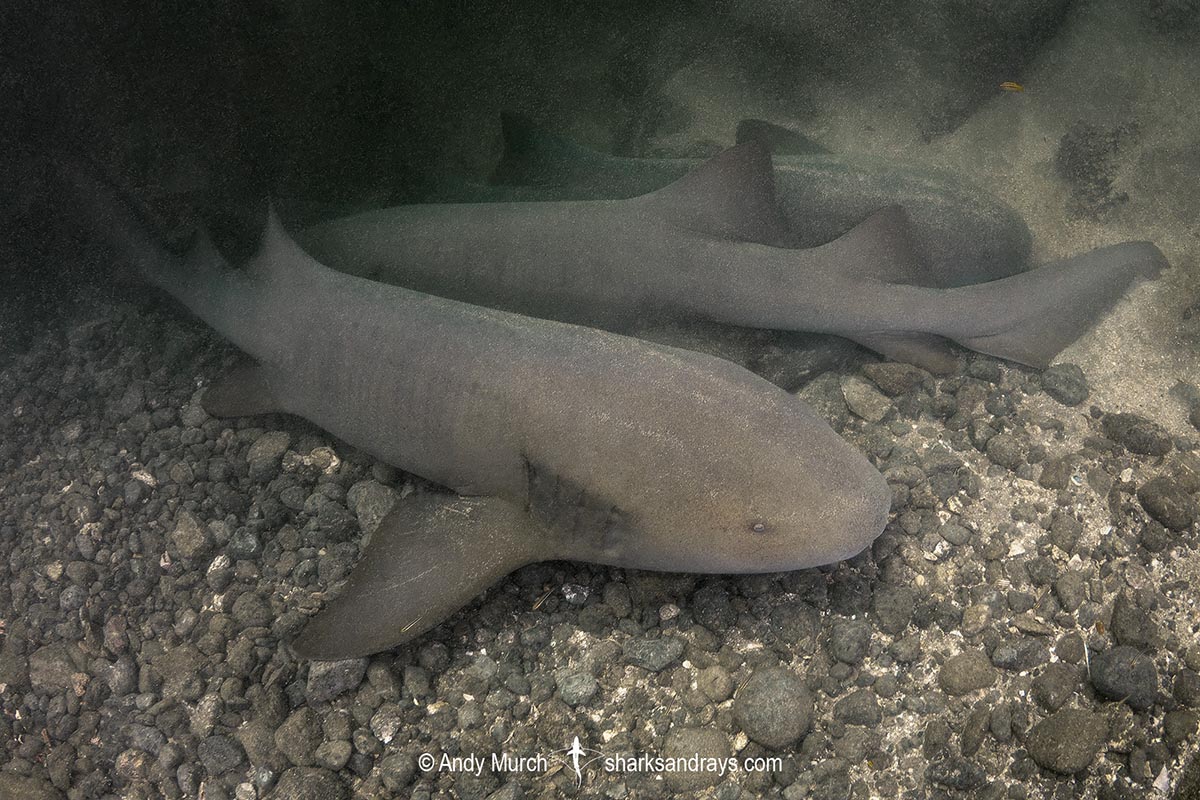Common names
Pacific Nurse Shark, Unami Nurse Shark.
Binomial
Ginglymostoma unami.
Synonyms
None.
Identification
Head broad. Snout short and bluntly rounded. Mouth small. Nasal flaps form long, thin barbells. First dorsal fin positioned far back on body, the origin slightly anterior of pelvic fin origins. Second dorsal large but smaller than first. Second dorsal fin origin midway between pelvic fin free rear tip and anal fin origin. Lower caudal lobe indistinct. Dorsal coloration tan to dark brown. Neonates and small juveniles (up to 45cm) may have subtle light and dark bands and small scattered dark spots that fade with age. Small juveniles are rarely seen. Ventral surface white, cream, or blotchy.
G. unami differs from G. cirratum (from the Caribbean) by having a shorter distance between the second dorsal fin and the the caudal lobe, and by the position of the first dorsal fin insertion. And in the form and number of keels on the dermal denticles
Size
Maximum length 280cm. Size at birth unknown but probably similar to its Caribbean cousin i.e. around 27-30cm.

Conservation Status
ENDANGERED
In the 1980s, the Pacific Nurse Shark was relatively abundant in the Gulf of California. Catch records from the late 1990’s revealed that it had been completely extirpated from that region. By the early 2000s, the same was true in Guatemala. Although never common in South America, no recent records exist from Colombia either.
The only sanctuary where the Pacific nurse shark appears to be hanging on is within the coastal marine parks of Costa Rica and Panama. The main reason for its dramatic decline is largely unmanaged artisanal fisheries and the degradation of coastal mangroves which serve as nursery grounds for this species.

Habitat
A tropical species preferring shallow sandy bays, coral reefs, and sea grass beds. Usually found on or near the bottom. Maximum depth unknown.
Distribution
Confined to the eastern tropical Pacific Ocean between the Gulf of California and Peru.
Reproduction
Almost certainly an aplacental viviparous species (without a yolk-sac placenta). Litter size unknown.
Diet
Unknown but probably small fishes, crustaceans, and other invertebrates.
Behavior
No migration data exists for this species. I repeatedly witnessed 5-6 Pacific nurse sharks resting in a shallow channel close to the intertidal line near Playa del Coco in Costa Rica. According to my dive master, the sharks rest in that particular spot during the cooler months, likely because it is warmer than other potential resting areas that sit below a severe thermocline.
Reaction to divers
I found this species to be extremely shy; bolting as soon as they noticed my presence. Likely this was because they were not used to being closely approached. However, I have heard of divers being able to make close approaches towards resting sharks.
Diving logistics
Rarely encountered by divers. The Pacific nurse shark can be encountered by divers in Playa Del Coco at a dive site called the Washing Machine. This is a shallow site at Isla Catalina where up to a dozen or more animals congregate in a small hole in the reef. Likely, they remain in this surge swept area because it is noticeably warmer than deeper sites nearby. Unfortunately, the dive site is heavily affected by the omnipresent Pacific swells so it is difficult to reach unless conditions are very good. Even then, visibility can be poor, and the sharks tend to bolt almost immediately.
The nurse shark aggregation at the Washing Machine was only recently discovered so it is unclear if the sharks utilize the site all year long or if they remain there only when the surrounding water is too cold. Six sharks were present when I dove at this site in March 2019.
The Pacific nurse shark can also be encountered during the warmer months at one or two sites around Coiba Island in Panama.
What’s new
View our full list of updates
Similar species
No other sharks in the eastern Pacific have long barbells like the Pacific nurse shark.


